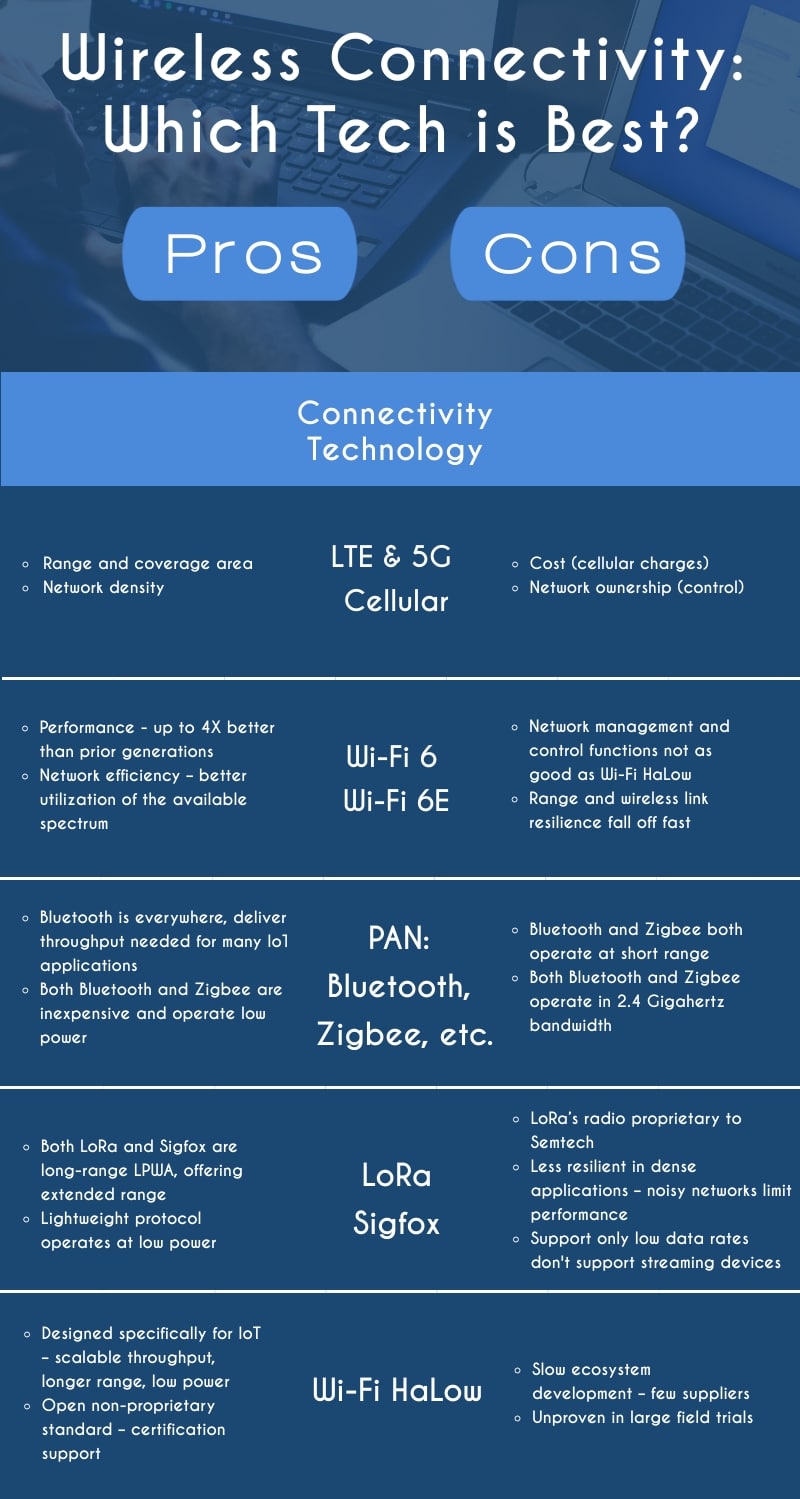Kevin Walsh
Executive Vice President, Strategic Marketing
Palma Ceia SemiDesign
It’s nearly impossible to consume any media about technology and not see a story about new Wi-Fi products. New use cases spring up on a seemingly daily pace, and technologists waste no time developing products to serve them. When it comes to connectivity, product designers have a range of options to choose from when developing their wireless products, and choosing the appropriate one depends on the use case.
For instance, Industry 4.0 requires an array of capabilities that are difficult to achieve with just one wireless standard, as IoT devices used in industrial applications have a wide range of requirements. For IoT, the 5G standard offers a specific radio, called NB-IoT, which narrowly defines operation low power-low complexity applications. All wireless standards are evolving to offer more capabilities.
Let’s look at 5 technology choices on the menu of wireless options, review where each is best suited and see how they compare.
LTE and 5G Cellular
As cellular moves from 4G to 5G, capabilities like LTE Cat M and LTE Cat NB-IoT are targeting the IoT market. The 3rd Generation Partnership Program (3GPP) umbrella organization for cellular standards has continued to move cellular into IoT. Throughput is the dividing factor for cellular radio options. LTE Cat M (M1) supports megabit throughput, whereas LTE Cat NB-IoT supports kilobit throughput.
The main drawback of cellular solutions is financial, not technical. These solutions are licensed, and so mobile network operators are charged for access to cell towers. And because all devices accessing the networks must be certified to operate on those networks, cost and control both have an impact.
Pros:
- Range and coverage area
- Network density
Cons:
- Cost (cellular charges)
- Network ownership (control)
Wi-Fi 6 and 6E: Wi-Fi The Next Generation
 Wi-Fi 6 and 6E are the latest generation Wi-Fi standards based upon the IEEE 802.11ax standard. They increase the performance and density by up to 4 times that of Wi-Fi’s previous generation — Wi-Fi 5, the designation for the IEEE 802.11ac standard — and so are called High Efficiency WLAN. Wi-Fi 6E targets the same feature set on the new 6G spectrum recently opened in the United States. Other countries are exploring this spectrum for Wi-Fi 6E as well, possibly creating worldwide standard.
Wi-Fi 6 and 6E are the latest generation Wi-Fi standards based upon the IEEE 802.11ax standard. They increase the performance and density by up to 4 times that of Wi-Fi’s previous generation — Wi-Fi 5, the designation for the IEEE 802.11ac standard — and so are called High Efficiency WLAN. Wi-Fi 6E targets the same feature set on the new 6G spectrum recently opened in the United States. Other countries are exploring this spectrum for Wi-Fi 6E as well, possibly creating worldwide standard.
Wi-Fi 6 includes some features targeting IoT:
- It describes a 20MHz-only device, which will be of lower complexity and hence lower cost and lower power.
- It also describes subdividing the 20MHz channel into as many as nine different Resource Units (RUs) each capable of supporting a device (for up to nine devices).
- Using the new orthogonal frequency domain multiple access (OFDMA) feature of Wi-Fi 6, more IoT device density can be handled. OFDMA subdivides the channel in time and frequency allowing the channel to be used more efficiently (smaller Rus).
- Wi-Fi 6 has borrowed the Target Wake Time (TWT) feature from the Wi-Fi HaLow protocol – more on that in a minute. With TWT, battery-powered devices can sleep when channel communication is not required, saving valuable battery power.
Wi-Fi 6 has defined specific features for IoT but lacks the additional network management and control functions available via Wi-Fi HaLow, especially for dense IoT networks. Features such as Resource Allocation Windows as well as narrower channels like 1MHz and 2MHz align better with the operational requirements of Industrial IoT. Further, Wi-Fi HaLow operates below the gigahertz frequency bands of Wi-Fi 6 – increasing the range and improving the signal propagation significantly.
Pros:
- Performance - up to 4X better than prior generations
- Network efficiency – better utilization of the available spectrum
Cons:
- Network management and control functions not as good as Wi-Fi HaLow
- Range and wireless link resilience fall off fast
PAN Standards: BLE, Zigbee and More
Personal Area Network (PAN) standards such as Bluetooth (BLE) and Zigbee have been around for years. These standards have been used to support short connectivity devices like wireless headsets and earphones for some time. In recent years they have been used in IoT devices as well.
These standards have added meshing to extend their range, but meshing reduces battery life, because even devices not in use must forward data, and hence remain active in the mesh network.
And the industrial environments of Industry 4.0 are particularly rough on these PAN protocols. The EMI interference and the density of equipment and lack of “line of sight” for the wireless channels simply does not work with these protocols, making BLE and Zigbee a poor choice for Industrial applications.
Pros:
- Bluetooth is everywhere and delivers the throughput necessary for many IoT applications
- Both Bluetooth and Zigbee are inexpensive and operate at low power
Cons:
- Bluetooth and Zigbee both operate at short range (<12 meters)
- Both Bluetooth and Zigbee operate in 2.4 Gigahertz bandwidth contenting with themselves and with Wi-Fi 4 (IEEE 802.11n) for clear channels
LoRa, Sigfox et al.: Proprietary Solutions
LoRa and Sigfox are proprietary standards used in IoT networks. Both these technologies use communication techniques developed before IoT was a glint in anyone’s eye. They use communication techniques less sophisticated than the cellular and Wi-Fi standards that were defined with IoT in mind.
The major drawback of these standards is how they handle contention in dense networks. They have extremely poor density-handling techniques. As such, the performance of their networks degrades quickly as devices haplessly try and communicate simultaneously. The results are that data is lost, or latency suffers.
One additional drawback is the fact that these are proprietary solutions, each pushed primary by a commercial entity. The fact they are not open standards gives these companies leverage over customers.
Pros:
- Both LoRa and Sigfox are long-range LPWA – low-power wide area – wireless protocols, offering extended range
- Lightweight protocol operates at low power
Cons:
- LoRa’s radio is proprietary to Semtech
- Both protocols are simple and less resilient in dense applications – noisy networks limit performance
- Both support only low data rates – no support for streaming devices
Wi-Fi HaLow: Let’s Talk Wi-Fi IoT
Wi-Fi HaLow is the Wi-Fi Alliance’s designation for the IEEE standard 802.11ah, which was ratified in 2016 and published in early 2017. The IEEE community defined a radio and protocol standard specifically targeting IoT devices.
Why do we need another wireless communication capability for IoT? The radio and protocol elements defined in Wi-Fi HaLow’s specification make it an ideal communications standard for IoT devices, thanks to two essential attributes:
- It is a sub-gigahertz radio standard, which adds longer range with scalability and efficiency.
- It is specifically designed as an IoT-handling protocol, managing and optimizing wireless communication between devices.
As a sub-gigahertz radio standard (operating below 1 GHz), Wi-Fi HaLow has better propagation characteristics than traditional Wi-Fi. Put simply, a sub-gigahertz radio transmits better through obstacles. You experience less propagation loss, or signal loss, based on obstructions and distance.
Wi-Fi HaLow devices transmit farther than Wi-Fi devices operating in 2.4G and 5G, and the new 6G frequencies. It is hard to transmit at long range in industrial environments and still maintain a robust connection. Wireless connections can be particularly tricky in indoor industrial areas, which are typically crowded with equipment which generates electromagnetic interference (EMI). This raises havoc with wireless connections, especially Bluetooth and Zigbee connections.
IoT networks frequently need to support thousands of devices, which has inherent problems. Wi-Fi HaLow has specific features which enable better management of large networks.
And whether the application requires operating stand alone or as part of a Wi-Fi ecosystem, Wi-Fi HaLow is a good choice. Wi-Fi HaLow’s scalability in range and throughput makes it an ideal last-kilometer and indoor factory solution. With more manufacturing moving to “lights-out” operation, where factories are completely automated, Wi-Fi HaLow’s capabilities can provide remote monitoring alongside cellular.
Pros:
- Designed specifically for IoT – scalable throughput, longer range, low power, and support for larger networks
- Open non-proprietary standard – certification support
Cons:
- Slow ecosystem development – few suppliers
- Unproven in large field trials
As we’ve seen, making a choice from the array of options in the connectivity toolbox depends on what you’re building. They all involve tradeoffs, but the advantages of Wi-Fi 6 and Wi-Fi HaLow standards for IoT applications give those protocols a leg up. For now.
Kevin Walsh joined Palma Ceia SemiDesign in 2016 and has more than 25 years of experience in semiconductor, IP and EDA. He has an extensive background in marketing, including strategic and tactical planning, mergers and acquisitions, establishing distribution channels and joint marketing partnerships. Most recently he worked for Faraday Technology as Vice President of Strategic Marketing. He was Executive Vice President and a founder at Sapphire Design Automation, as well as Vice President of Marketing at Simplex Solutions. Other previous roles include serving as Vice President of Marketing and Director of Marketing at Gennum, Semtech, inSilicon, Arasan Chip Systems and Synopsys. He holds a Bachelor of Science degree in Electrical Engineering and Computer Science from the University of California, Berkeley, and an MBA from Pepperdine University.

